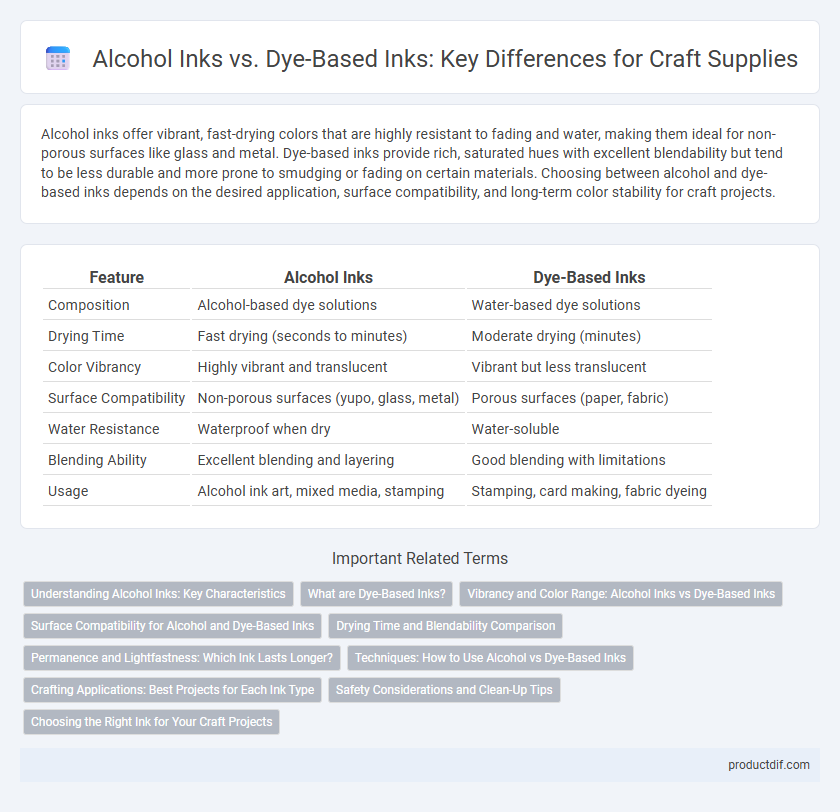Alcohol inks offer vibrant, fast-drying colors that are highly resistant to fading and water, making them ideal for non-porous surfaces like glass and metal. Dye-based inks provide rich, saturated hues with excellent blendability but tend to be less durable and more prone to smudging or fading on certain materials. Choosing between alcohol and dye-based inks depends on the desired application, surface compatibility, and long-term color stability for craft projects.
Table of Comparison
| Feature | Alcohol Inks | Dye-Based Inks |
|---|---|---|
| Composition | Alcohol-based dye solutions | Water-based dye solutions |
| Drying Time | Fast drying (seconds to minutes) | Moderate drying (minutes) |
| Color Vibrancy | Highly vibrant and translucent | Vibrant but less translucent |
| Surface Compatibility | Non-porous surfaces (yupo, glass, metal) | Porous surfaces (paper, fabric) |
| Water Resistance | Waterproof when dry | Water-soluble |
| Blending Ability | Excellent blending and layering | Good blending with limitations |
| Usage | Alcohol ink art, mixed media, stamping | Stamping, card making, fabric dyeing |
Understanding Alcohol Inks: Key Characteristics
Alcohol inks are highly pigmented, fast-drying dyes dissolved in alcohol, known for their vibrant, translucent colors and ability to blend seamlessly on non-porous surfaces like glass, metal, and plastic. They offer excellent durability, resistance to fading, and create unique marbled or fluid effects ideal for mixed media art and crafting. Unlike dye-based inks that absorb into porous materials, alcohol inks sit on the surface, allowing for reactivation and manipulation with alcohol or blending solutions.
What are Dye-Based Inks?
Dye-based inks are liquid inks composed of colorant molecules dissolved in a solvent, offering vibrant and translucent colors ideal for craft projects like stamping and calligraphy. These inks absorb quickly into porous surfaces such as paper and fabric, delivering bright hues but with less water resistance compared to pigment inks. Popular dye-based ink brands include Ranger and Tsukineko, favored for their ease of blending and wide color range in crafting applications.
Vibrancy and Color Range: Alcohol Inks vs Dye-Based Inks
Alcohol inks offer exceptional vibrancy and a wide color range due to their fast-drying, highly pigmented formula, making them ideal for bold, vivid craft projects. Dye-based inks provide softer, more translucent colors with a more limited palette, often resulting in subtle gradients and blends. The choice between alcohol and dye-based inks depends on the desired intensity and color depth in crafting applications.
Surface Compatibility for Alcohol and Dye-Based Inks
Alcohol inks are highly compatible with non-porous surfaces such as glass, metal, and ceramic, where they create vibrant, translucent effects. Dye-based inks perform best on porous materials like paper and fabric, allowing deep penetration and rich color absorption. Choosing the appropriate ink depends on the specific surface to achieve optimal craft results and durability.
Drying Time and Blendability Comparison
Alcohol inks dry significantly faster than dye-based inks, often within minutes, making them ideal for quick projects. Their fast drying time enables smooth blending and layering without smudging, while dye-based inks require longer drying periods and can result in muddy blends. The superior blendability of alcohol inks allows artists to achieve vibrant gradients and seamless color transitions with ease.
Permanence and Lightfastness: Which Ink Lasts Longer?
Alcohol inks exhibit superior permanence and lightfastness compared to dye-based inks, maintaining vibrant colors without fading over extended periods. Their solvent-based formulation enables resistance to water and UV exposure, making them ideal for long-lasting art projects and crafts. Dye-based inks tend to be more susceptible to fading and degradation when exposed to light and moisture, limiting their durability in outdoor or high-traffic applications.
Techniques: How to Use Alcohol vs Dye-Based Inks
Alcohol inks require non-porous surfaces like Yupo paper or ceramic tiles to achieve vibrant, flowing effects that blend seamlessly through techniques such as layering, tilting, and using blending solutions. Dye-based inks perform best on porous materials like fabric and paper, offering crisp lines and color saturation ideal for stamping, stenciling, and watercolor techniques. Mastering ink dilution, drying times, and surface compatibility enhances the control and final appearance in crafts using both alcohol and dye-based inks.
Crafting Applications: Best Projects for Each Ink Type
Alcohol inks offer vibrant, fast-drying colors ideal for non-porous surfaces like glass, metal, and ceramics, making them perfect for creating striking abstract art, resin crafts, and decorative tiles. Dye-based inks provide excellent absorption on porous materials such as fabric, paper, and wood, making them suitable for scrapbooking, fabric stamping, and card making. Choosing between these inks depends on the material and desired effect, with alcohol inks excelling in bold, fluid designs and dye-based inks preferred for detailed, soak-in color projects.
Safety Considerations and Clean-Up Tips
Alcohol inks feature high volatility and flammability, requiring use in well-ventilated areas and avoidance of open flames to ensure safety. Dye-based inks are generally water-soluble and less toxic, making them safer for indoor use and easier to clean with mild soap and water. Proper disposal methods for alcohol ink waste prevent environmental harm, while dye-based stains can typically be removed from surfaces with household cleaners and water.
Choosing the Right Ink for Your Craft Projects
Alcohol inks offer vibrant, fast-drying colors ideal for non-porous surfaces like glass, metal, and ceramics, making them perfect for fluid art and mixed media projects. Dye-based inks provide rich, translucent hues that absorb well into porous materials such as paper and fabric, ensuring longevity and smooth blending for stamping and scrapbooking. Selecting between alcohol inks and dye-based inks depends on your project's surface type and desired color intensity.
Alcohol inks vs Dye-based inks Infographic

 productdif.com
productdif.com